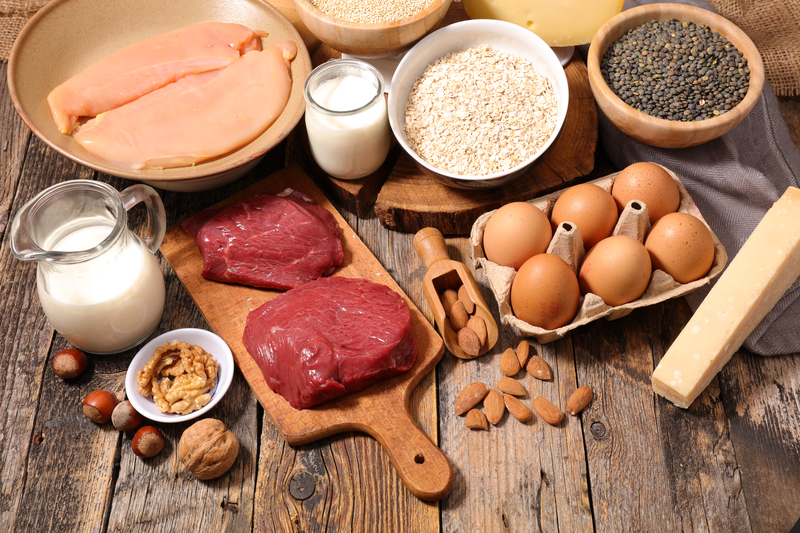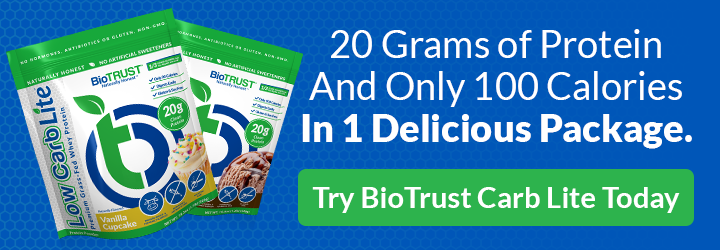High-Protein Diet: What are the Benefits (and is it right for you)?

The high-protein diet is one of the most popular, trendiest dietary approaches for weight loss these days. But just because everybody else is talking about it doesn’t make it right…right? Why do we need protein anyway? How much protein do you need? How much protein should you eat to lose weight? What are the best protein foods for weight loss? Is a high-protein diet right for you? Find out the answers to these questions and more!
Why Do We Need Protein?
Dietary protein is an umbrella term that refers to organic molecules made up of amino acids, which are known as the building blocks of life. When we eat foods containing protein, we break it down (or, digest it) into its constituent amino acids. Then, our bodies use said amino acids to build new proteins, which are vital for growth, repair, and maintaining healthy bodily functions.
For example, the body uses proteins to build and repair tissues, including skin and lean muscle mass. Our bodies also use amino acids to make proteins that function as:
- Enzymes
- Hormones
- Antibodies
- Neurotransmitters
- Transportation chemicals
What’s more, dietary protein may offer additional benefits beyond those primary functions. In other words, there appear to be clear advantages to consuming more protein than is “required” (i.e., high-protein diet) for “normal” growth and repair.
We’ll dive deeper into the benefits of a high-protein diet in the next section, but for now, let’s talk more about those building blocks of life. Historically, amino acids have been divided into two categories: essential and nonessential. This categorization is convenient and generally useful. However, it’s becoming increasingly evident that these nice lines may not be quite so clear, especially as we better understand the unique functions and needs for individual amino acids.
Be that as it may, there are three commonly accepted classifications of amino acids. Essential amino acids, often called “indispensable” amino acids, are those the body can’t make. And that means we need to consume them in the diet. These include:
- Histidine
- Isoleucine
- Leucine
- Lysine
- Methionine
- Phenylalanine
- Threonine
- Tryptophan
- Valine
Conditional, or conditionally essential, amino acids are those the body has the capability to produce in a limited capacity. For example, the body’s production of these amino acids may be limited by the availability of “raw materials,” and there are certain circumstances (such as periods of stress) when the body’s requirements for these amino acids may be higher.1 Nonetheless, here are the conditional amino acids:
- Arginine
- Cysteine
- Glutamine
- Glycine
- Proline
- Tyrosine
Nonessential amino acids, also referred to as “dispensable” amino acids, are those the body can typically make for itself. However, from a functional perspective, all amino acids are essential.1 Having said that, the following amino acids are typically categorized as “nonessential”:
- Alanine
- Asparagine
- Aspartic acid
- Glutamic acid
- Serine

How Much Protein Do I Need?
As I mentioned above, it’s becoming increasingly clear that there are benefits to consuming more than just “enough” protein. In other words, a high-protein diet that includes more (even considerably more) protein than what’s “required” may offer additional advantages.
So, a better question than “How much protein do I need?” would be, “How much protein is optimal for reaping all the benefits of a high-protein diet, such as better health, more calorie-burning lean muscle and strength, less body fat, and better metabolic function?”
Believe it or not, it can depend on a number of factors, including:
- Your body weight
- Your body fat percentage
- Your age
- Your physical activity and exercise habits
- Your goals
- Your overall diet
- Your food preferences
And while a personalized protein prescription is always going to be the best bet, we have a pretty good idea of what an ideal range may be for a high-protein diet. For example, a recent systematic review and meta-analysis showed that a good target for most people (who are exercising regularly) is 1.6 grams of protein per kilogram of body weight per day (1.6g/kg/day), which translates to about 0.73 grams per pound of body weight per day.2
Of course, that’s just an average and a high-protein diet that’s ideal for you may range from 1.03 – 2.2g/kg/day. And there’s even some research showing that protein intake as high as 4.4g/kg/day (that’s 2 grams per pound) is not only safe, it may be beneficial.3 Practically speaking, a high-protein diet is generally in the neighborhood of 0.6 – 1.0 grams of protein per pound per day, and the middle-ish of the range (0.73g/lb/day) is a good target for most people seeking to look, feel, and perform better.
How Much Protein Should I Eat to Lose Weight?
While a high-protein diet has a variety of applications and can be a useful tool for a range of folks to achieve a spectrum of goals, there’s no question that high-protein diets have become particularly trendy in recent years for weight loss, and there’s little disagreement that high-protein diets can be quite effective for weight loss and maintenance.4
In general, a high-protein diet offers several distinct metabolic advantages:
- Boosts metabolic rate and increases caloric expenditure
- Increases satiety, helps improve diet quality, and helps reduce caloric intake
- Protects and builds calorie-burning lean muscle
For example, the metabolism-boosting action (called the thermic effect of feeding) of protein is anywhere from TWO to TEN TIMES that of carbs or fat.1 In other words, you burn more calories each day when you consume a high-protein diet, and it also means that protein-rich foods provide less metabolizable energy (than carbs or fats)—meaning your body is less likely to store calories from protein as fat.2
Another major metabolic advantage of a high-protein diet is increased satiety and improved appetite control. In other words, high-protein diets can help reduce caloric intake, decrease cravings, and improve diet quality. Similar to its thermogenic burn effect, high-protein meals/foods have a much more pronounced effect on satiety and appetite control compared to carbs or fats.3,4
What’s more, research consistently shows a high-protein diet is essential for preserving calorie-burning lean muscle when dieting. This is key because losing precious lean mass can lead to reduced metabolic rate, increased appetite, greater likelihood of weight re-gain, and a host of potential negative health consequences.
When it comes to how much protein for weight loss, the recommendation above is a good starting point. In other words, forget the recommended dietary allowance (RDA) of 0.8 grams of protein per kilogram of body weight per day (or, about 0.36 grams of protein per pound of body weight).
If you’re interested in reaping the metabolic advantages of a high-protein diet, research indicates that you may need up to TWICE the RDA (or even more). A better target is somewhere in the neighborhood of 1.6g/kg/day (roughly 0.73g/lb/day), although more seems to be perfectly fine. Note that if you have a fair amount of weight to lose (say more than 20 pounds), you might consider setting your daily protein goal based on your target weight.

Protein Foods for Weight Loss
When it comes to reaping the benefits of a high-protein diet, quality counts. Along those lines, it’s best to emphasize “high-quality” protein sources, and more specifically, protein quality refers to the balance of amino acids (with an emphasis on the essential amino acids), the digestibility of the protein, and the availability of the absorbed amino acids.
While it’s certainly possible to get enough protein by eating an exclusively plant-based diet, animal-based protein sources reign supreme as high-quality protein options. On the other hand, vegetarian sources (such as beans, rice, and peas) tend to score lower for protein quality on an isolated basis, and if you’re vegan, you typically have to eat more protein, combine proteins, and/or add digestive enzymes to get on an even playing field with animal-based protein sources. Another way to think about it is that high-quality, animal-based proteins deliver a higher protein density along with a lower calorie content compared to plant-based proteins.
All that being said, here are some of the top protein-rich foods to round out an overall healthy high-protein diet:
- Meat and poultry (preferably from grass-fed, pasture-raised animals) and wild game
- Dairy (preferably from organic, grass-fed, pasture-raised animals), including:
- Yogurt and Greek yogurt
- Cottage cheese
- Kefir
- Fatty fish and seafood (preferably sustainably and responsibly sourced), including:
- Wild salmon
- Pacific sardines
- Mussels
- Atlantic mackerel
- Oysters
- Anchovies
- Rainbow trout
- Herring
- Eggs (preferably from organic, pasture-raised hens)
- Protein supplements, including:
- Whey protein (hormone- and antibiotic-free, grass-fed, pasture-raised cows)
- Milk protein blend (hormone- and antibiotic-free, grass-fed, pasture-raised cows)
- Plant-based protein blend (complementary proteins, digestive enzymes added)
- Plant-based foods relatively rich in protein, including:
- Nuts
- Seeds
- Beans
- Lentils
- Peas
- Sprouted foods
How about an example? You bet! Based on a target of about 0.7ish grams of protein per pound per day, a 150-pound person who lifts weights a few times a week should consume about 110 grams of protein per day. Since we don’t eat protein per se, but rather, we eat food, here’s how that person might hit that protein target:
- 3 whole eggs (18 grams)
- 1 whey protein shake (25 grams)
- 1 cup Greek yogurt (22 grams)
- 1 cup lentils (18 grams)
- 5 ounces salmon (28 grams)

Who Should Eat a High-Protein Diet?
For otherwise healthy folks, a high-protein diet is perfectly safe. Heck, there’s even some research showing that protein intake as high as 4.4g/kg/day (that’s 2 grams per pound) is not only safe, it may be beneficial.3 And the misconception that a high-protein diet is potentially detrimental to otherwise healthy kidneys is, to be blunt, just a myth.
With that—and the potential benefits—in mind, it seems like a high-protein diet would be a pretty sound recommendation for pretty much everyone. As we’re learning more and more about nutritional genetics and personalized nutrition, we may find that some people are particularly well-suited for a high-protein diet. For example, there’s some compelling research that a high-protein diet may be especially beneficial for weight loss for folks with a variant of the FTO gene, which is called the fat mass and obesity-associated gene because of its role in regulating body weight. Some even refer to FTO as the “fat gene.” Be that as it may, folks with the FTO variant (AA homozygous genotype, if you’re interested) typically weigh about 6 pounds more than folks without.5–8
As we learn more about the increasingly-fascinating gut microbiome, we may find that certain people may want to shy away from a high-protein diet. For example, certain gut bacteria can convert components from different protein sources (eggs and meat, for instance) into trimethylamine and trimethylamine oxide (TMAO). Research suggests that high levels of TMAO may be associated with heart disease and even obesity. We have to be careful with that association, however, because it’s not known whether TMAO is the mediator or a bystander, especially considering there are often other “problems” going on behind the scenes (such as impaired kidney function).9,10
With that being said, a high-protein diet seems to be a useful tool for quite a few folks, and there’s a good chance it can be effective for you if:
- You’re an athlete
- You exercise intensely 5 or more times per week
- You want to lose fat while maintaining/building muscle
- You want to gain muscle
- You want to lose or maintain weight
- You struggle with appetite management and cravings
- You are older than 50
- You are recovering from injury
Yeah, that pretty much covers the gamut, doesn’t it? The truth is that while there’s plenty of solid research in support of a high-protein diet, some speculate that the long-term effect of a high-protein diet is neither consistent nor conclusive.4,11 In other words, there’s still some more learning to do, and we cannot ignore the sage premise that individual differences may apply.
Something else I think is relevant and important to point out is that you don’t necessarily need to eat high-protein all-day, every day. In fact, there may be some anti-aging benefits to lowering protein intake every once in a while, whether that’s cycling protein intake or incorporating some form of intermittent fasting, such as a fast-mimicking diet or time-restricted feeding. On the flipside, I don’t think it’s such a great idea to be eating high-protein meals every 2 – 3 hours as popularly advocated by the bodybuilding and fitness community. Heck, I don’t think it’s a great idea to be eating every 2 – 3 hours as it is.







